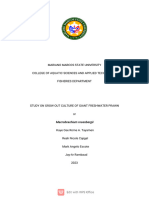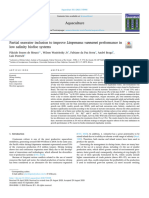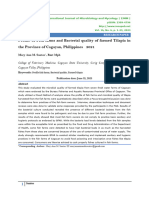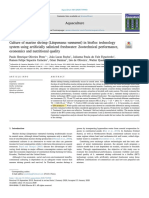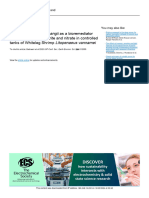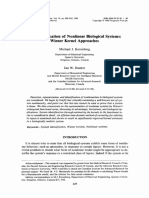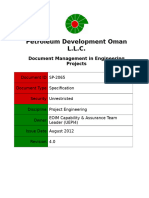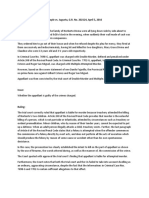Pond Culture of The Giant Freshwater Prawn (Ulang) : Harvest and Postharvest Handling
Pond Culture of The Giant Freshwater Prawn (Ulang) : Harvest and Postharvest Handling
Uploaded by
Robert Anthony BermudezCopyright:
Available Formats
Pond Culture of The Giant Freshwater Prawn (Ulang) : Harvest and Postharvest Handling
Pond Culture of The Giant Freshwater Prawn (Ulang) : Harvest and Postharvest Handling
Uploaded by
Robert Anthony BermudezOriginal Title
Copyright
Available Formats
Share this document
Did you find this document useful?
Is this content inappropriate?
Copyright:
Available Formats
Pond Culture of The Giant Freshwater Prawn (Ulang) : Harvest and Postharvest Handling
Pond Culture of The Giant Freshwater Prawn (Ulang) : Harvest and Postharvest Handling
Uploaded by
Robert Anthony BermudezCopyright:
Available Formats
2.
4; and 1% mortality apply in the population Harvest and Postharvest Handling
per week; and mean individual weight from • Drain water and collect prawns using the
samples obtained every 3 weeks) harvest net installed at the pond gate
• Feed 200 g per 10,000 postlarvae • Harvest prawns weighing at least 30 g
• Lift feeding tray after 1–3 hours and estimate
• Place the harvested prawns in a container
the feed consumed
• Feed prawns five times a day for 40 days of then sort according to size and place in boxes
culture at 6:00 A.M., 10:00 A.M., 2:00 P.M., with crushed ice to preserve quality
5:00 P.M., and 10:00 P.M. at 20%, 10%, 10%,
35%, and 25%, respectively, of the
total feeding ration
Water Management and Aeration PCAARRD Information Bulletin No. 14/2012
• Replace 10–20% of the water after 30 days of
culture from the reservoir ponds For more information, please contact:
• Allow the water from the reservoir ponds to
PCAARRD
stay for 4–5 days to replenish the water in Los Baños, Laguna
the prawn rearing ponds Tel. Nos.: (049) 536-0015 to 20
• Maintain the dissolved oxygen by using six Fax Nos. (049) 536-0016/536-7922
Email: pcarrd@pcarrd.dost.gov.ph
paddle-wheel aerators Website: http://www.pcarrd.dost.gov.ph
• Operate four aerators alternately for 24 hours
for intensive culture system for the first
60 days
DEPARTMENT OF TRADE & INDUSTRY
BUREAU OF MICRO, SMALL AND MEDIUM
Diseases Source: ENTERPRISE DEVELOPMENT (BSMED)
5/F, Trade and Industry Building
• Aggression or mishandling of prawns causes 361 Sen. Gil J. Puyat Ave. Makati City
Trunkline No.: 751.0384
infection Philippine Council for Aquatic and Marine Tel. Nos. (02) 897.1693 / 897.7596 / 890.4968
• Lack of nutrients and vitamins in feeds Research and Development; Mindanao State Fax No. (02) 896.7916 l Email: bmsmed@dti.gov.ph
www.dti.gov.ph
causes pigment loss in prawns University-Naawan; Philippine Council for
Agriculture, Forestry and Natural Resources
• Malnutrition in prawns causes “molting death”
syndrome
Research and Development. Pond culture of
the giant freshwater prawn (Macrobrachium
PHILIPPINE COUNCIL FOR AGRICULTURE, AQUATIC
AND NATURAL RESOURCES RESEARCH AND
Pond Culture of the
DEVELOPMENT (PCAARRD)
rosenbergii): A poster. Los Baños, Laguna:
PCAMRD, (undated).
Department of Science and Technology (DOST)
Giant Freshwater
Prawn (Ulang)
Ulang (Macrobrachium rosenbergii) Steps in Culturing Ulang in Ponds • Banks with fast growing grass to prevent Intensive
erosion, and banana, papaya, and palm trees • 21 postlarvae and above/m2
• Most popular freshwater prawn for Site Selection to form as wind breakers • Production of more than 5,000 kg/ha/yr
commercial culture • Adequate quality water source • Use of nutritionally complete feed
• Good alternative for tilapia or tiger prawn • Proximity to market Pond Preparation • Strict control over all aspects of water quality
culture • Flat or gently sloping (1–3%) and safe from • Dry pond
• Breeds easily and can reach a marketable flood
size of 3 pieces per kilo in 6–9 months of • Eradicate potential competitors, pests, and Stock Management
• Impervious, clay loam to sandy clay soil with
culture pH 6.5–7.0 parasites using teaseed powder (20 ppm). • Continuous system – continuously stock and
• Has export potential and an established Allow two weeks to eliminate toxins. select harvestable prawn for market
market niche • Apply agricultural limestone (if soil pH<6.5) • Batch system – stock and wait until the stock
• Has polyculture potential and can be cultured • Fill the pond with water (1.0–1.2 m) then seal reaches the average marketable size
in dams, ponds, lakes, cages, and pens the gates • Combined system – combination of 1st and 2nd
• Fertilize pond with chicken manure (1,000–
Farm Implements Needed
2,000 kg/ha) and 16-20-0 (100–200 kg/ha)
every two weeks, at a lower dose than the
The basic farm tools in ulang culture are seine
and scoop nets, water pump, weighing scale, basal rate to sustain the plankton production
cutting tools, feeding tray, digging blade, spade, • Maintain grass around the pond to prevent
and cast net. soil erosion
Farming Intensity
Extensive systems
• 1–4 postlarvae or juveniles/m2
Pond Description • Production capacity of less than 500 kg/ha/yr
• Rectangular surface area (0.5–2.0 hectare) • Supplemental feeding is not normally supplied
• Smooth bottom and free from obstructions for • Organic fertilization rarely applied Feeding Management
seining • Feed after stocking
• Minimum depth of 60–90 cm at shallow end Semi-intensive • Broadcast feed around the pond (portion of
and a maximum depth of 100–150 cm at deep • 5–20 postlarvae or juveniles/m2 the feeding ration left in the feeding trays)
end
• Production capacity of more than 500 kg/ha/yr • Install four trays measuring 0.25 m2 each to
• Bank slope embankment with 30–60 cm
freeboard; internal slope of 2.5:1, 3:1, or 4:1; • Balanced feed ration is supplied monitor the feeds consumed everyday
and external of 1.5:1–2.5:1 • Fertilization used • During the first 30 days, blind feeding (base
feeding schedule on a conversion ratio of
You might also like
- PreviewpdfDocument66 pagesPreviewpdfmdiez775No ratings yet
- Graphic Designing Course OutlineDocument4 pagesGraphic Designing Course OutlineB pradhan100% (2)
- Extrinsic Semiconductors 2 FinalDocument5 pagesExtrinsic Semiconductors 2 FinalAniket Parikh100% (1)
- Fulltext AdoptionofAquasilvicultureTechnologyDocument6 pagesFulltext AdoptionofAquasilvicultureTechnologyStiltonNo ratings yet
- Peralta - Philippine Green Mussel Production, Post-Harvest, and MarketDocument37 pagesPeralta - Philippine Green Mussel Production, Post-Harvest, and Marketwish09No ratings yet
- Sustainable Crab Industry Development in Surigao Del SurDocument12 pagesSustainable Crab Industry Development in Surigao Del SurHannah Joy F. Fabellore100% (1)
- Davao Del Norte State College 0: Institute of Advanced StudiesDocument7 pagesDavao Del Norte State College 0: Institute of Advanced StudiesBenjie GarayNo ratings yet
- Case Study Presentation - Sea UrchinDocument13 pagesCase Study Presentation - Sea UrchinRalen Faye VillaseñorNo ratings yet
- 2-Manoj M SharmaDocument59 pages2-Manoj M SharmaduomareNo ratings yet
- Mini Book F 1201Document20 pagesMini Book F 1201Elizer Sagun BaranganNo ratings yet
- Tilapia CultureDocument2 pagesTilapia CultureferdinandNo ratings yet
- Ok - Fao - Org-4 AQUACULTURE METHODS AND PRACTICES A SELECTED REVIEWDocument49 pagesOk - Fao - Org-4 AQUACULTURE METHODS AND PRACTICES A SELECTED REVIEWVicente SalanapNo ratings yet
- Research Achievements of Aicrps On Agricultural EngineeringDocument30 pagesResearch Achievements of Aicrps On Agricultural EngineeringashisbhuniyaNo ratings yet
- Culture Performance and Economic Return of Brown ShrimpDocument8 pagesCulture Performance and Economic Return of Brown ShrimpLuã OliveiraNo ratings yet
- Distribution Patterns of Freshwater Prawn, Macrobrachium Spp. Following Stock Enhancement Programme in Sabah, MalaysiaDocument15 pagesDistribution Patterns of Freshwater Prawn, Macrobrachium Spp. Following Stock Enhancement Programme in Sabah, MalaysiaMamta AgarwalNo ratings yet
- كلوزيد سيستم واحواض طينيةDocument15 pagesكلوزيد سيستم واحواض طينيةHassan AL-HillaliNo ratings yet
- Grow-Out Culture of The Bay ScallopDocument10 pagesGrow-Out Culture of The Bay ScallopFlo Ga KikeNo ratings yet
- Camarin Et Al. 2020. Bacterial Microbiota of Hatchery-Reared Freshwater Prawn Macrobrachium Rosenbergii (De Man, 1879)Document8 pagesCamarin Et Al. 2020. Bacterial Microbiota of Hatchery-Reared Freshwater Prawn Macrobrachium Rosenbergii (De Man, 1879)Erlinda LacierdaNo ratings yet
- 4.seaweed Cultivation - Alternate Livelihood For Coastal Fisher PopulationDocument2 pages4.seaweed Cultivation - Alternate Livelihood For Coastal Fisher Population20uan033No ratings yet
- Aem 25Document28 pagesAem 25Edilyn San PedroNo ratings yet
- Milkfish Farm ProductionDocument31 pagesMilkfish Farm ProductionMika Patoc50% (2)
- JAMB-11-00348 Tine Et Al 2022Document10 pagesJAMB-11-00348 Tine Et Al 2022Nikkaa BonaguaNo ratings yet
- AquaCulture Asia Pacific Jan - Feb 18 - FA - LR174 PDFDocument72 pagesAquaCulture Asia Pacific Jan - Feb 18 - FA - LR174 PDFJoanna MordenNo ratings yet
- Antigonon Leptopus Hook. and Arn. A New Plant Origin Icthyotoxicant On Channa Punctata Bloch, 1793 For Aquaculture ManagementDocument11 pagesAntigonon Leptopus Hook. and Arn. A New Plant Origin Icthyotoxicant On Channa Punctata Bloch, 1793 For Aquaculture ManagementEditor IJTSRDNo ratings yet
- Comparative Study of Growth Performance of Three Tilapia Strain in Intensive Culture SystemDocument9 pagesComparative Study of Growth Performance of Three Tilapia Strain in Intensive Culture SystemDiego RodriguezNo ratings yet
- PDS Samal City Mariculture Park ProjectDocument47 pagesPDS Samal City Mariculture Park ProjectKumander BulakNo ratings yet
- The Financial Feasibility of Small-Scale Marine orDocument13 pagesThe Financial Feasibility of Small-Scale Marine orisuru gunathilakaNo ratings yet
- Astuti 2020 IOP Conf. Ser. Earth Environ. Sci. 535 012046Document8 pagesAstuti 2020 IOP Conf. Ser. Earth Environ. Sci. 535 012046Ivan MorningstarNo ratings yet
- Faq Icar CibaDocument40 pagesFaq Icar CibaSOUMASISH CHAKRABORTYNo ratings yet
- 2021 Partial Seawater Inclusion To Improve Litopenaeus Vannamei Performance in Low Salinity Biofloc Systems - ArtículoDocument8 pages2021 Partial Seawater Inclusion To Improve Litopenaeus Vannamei Performance in Low Salinity Biofloc Systems - ArtículoErnesto RonNo ratings yet
- Hendrajat Dan Sahrijanna, 2018Document10 pagesHendrajat Dan Sahrijanna, 2018IKE LISTYA ANGGRAENINo ratings yet
- Pacho - 2021 - IOP - Conf. - Ser. - Earth - Environ. - Sci. - 934 - 012051Document9 pagesPacho - 2021 - IOP - Conf. - Ser. - Earth - Environ. - Sci. - 934 - 012051Lendry NormanNo ratings yet
- IAF1801 Til2Document5 pagesIAF1801 Til2Ramon KourieNo ratings yet
- 13 Vibrio PDFDocument5 pages13 Vibrio PDFIJEAB JournalNo ratings yet
- Kondisi Gracilaria Di Kabupaten Bone Sulawesi SelatanDocument11 pagesKondisi Gracilaria Di Kabupaten Bone Sulawesi SelatanGhamal WahabNo ratings yet
- Composite Fish CultureDocument48 pagesComposite Fish Culturejoshigauta86% (7)
- DCXCXDocument17 pagesDCXCXsameh.eldahanNo ratings yet
- Aquaculture Research: Author InformationDocument4 pagesAquaculture Research: Author InformationAngeloLorenzoSalvadorTamayoNo ratings yet
- Prawn Hatchery Business Plan, Management - Agri FarmingDocument6 pagesPrawn Hatchery Business Plan, Management - Agri FarmingSUNILKUMARPAHARINo ratings yet
- Aung 2020 IOP Conf. Ser. Earth Environ. Sci. 420 012004Document12 pagesAung 2020 IOP Conf. Ser. Earth Environ. Sci. 420 012004SbenmohamedNo ratings yet
- Effects of Growth On Polychaete Rockworm Emmarphysa Sanguineaem Integrated Culture With Olive Flounder Emparalichythys oDocument6 pagesEffects of Growth On Polychaete Rockworm Emmarphysa Sanguineaem Integrated Culture With Olive Flounder Emparalichythys oraj78krNo ratings yet
- Shrimp Acquaculture: The Philippine Experience: Rolando R. PlatonDocument6 pagesShrimp Acquaculture: The Philippine Experience: Rolando R. PlatonChaii100% (1)
- Lwe 424 ReportDocument48 pagesLwe 424 ReportkssaludesNo ratings yet
- Development of Intensive Shrimp Farming, Litopenaeus Vannamei in Land-Based Ponds: Production and ManagementDocument7 pagesDevelopment of Intensive Shrimp Farming, Litopenaeus Vannamei in Land-Based Ponds: Production and ManagementEriNo ratings yet
- Profile of Fish Farms and Bacterial Quality of Farmed Tilapia in The Province of Cagayan, Philippines 2021Document23 pagesProfile of Fish Farms and Bacterial Quality of Farmed Tilapia in The Province of Cagayan, Philippines 2021Openaccess Research paperNo ratings yet
- gf180dfsggdfs6 8g91-Cab-2dsf0-E52300Document11 pagesgf180dfsggdfs6 8g91-Cab-2dsf0-E52300FADASDADSNo ratings yet
- Borges Zapata 3965 1 10 20200221Document9 pagesBorges Zapata 3965 1 10 20200221Abraham La Tuza Puc GilNo ratings yet
- Low Salinity Inland Shrimp Farming in ThailandDocument7 pagesLow Salinity Inland Shrimp Farming in ThailandosamaNo ratings yet
- Fish Hatchery Management in Nigeria PDFDocument12 pagesFish Hatchery Management in Nigeria PDFrudiheraNo ratings yet
- Fuzzy Logic-Based Adaptive Aquaculture Water MonitoringDocument7 pagesFuzzy Logic-Based Adaptive Aquaculture Water Monitoringude@No ratings yet
- Pengembangan Usaha Pembesaran Kepiting Bakau (Scylla SPP) Melalui Sistem SilvofisheryDocument8 pagesPengembangan Usaha Pembesaran Kepiting Bakau (Scylla SPP) Melalui Sistem SilvofisheryNovita Purwo NingtyasNo ratings yet
- Oliveira Pinto Culture of Marine Shrimp (Litopenaeus Vannamei) in Biofloc Technology System Using Artificially Salinized Freshwater ZootechnicalDocument6 pagesOliveira Pinto Culture of Marine Shrimp (Litopenaeus Vannamei) in Biofloc Technology System Using Artificially Salinized Freshwater ZootechnicalAngeloNo ratings yet
- macroDocument15 pagesmacronavyakatragadda777No ratings yet
- Fisheries - Shrimp CultureDocument15 pagesFisheries - Shrimp CultureSurya PalanivelNo ratings yet
- Aquasilviculture Project: A Techno-Demo For Sustainable Fisheries in Central LuzonDocument26 pagesAquasilviculture Project: A Techno-Demo For Sustainable Fisheries in Central LuzonAnne DoradoNo ratings yet
- 310 - Probiotic Use in Litopenaeus Vannamei FarmingDocument1 page310 - Probiotic Use in Litopenaeus Vannamei Farmingpenmetsa89No ratings yet
- Freshwater Aquaculture - KUFOSDocument36 pagesFreshwater Aquaculture - KUFOSBinu VargheseNo ratings yet
- Assessment of Heavy Metal Accumulation in Two Aquatic Macrophyte Tissues in Taylor Creek, Zarama, Bayelsa StateDocument6 pagesAssessment of Heavy Metal Accumulation in Two Aquatic Macrophyte Tissues in Taylor Creek, Zarama, Bayelsa StateInternational Journal of Innovative Science and Research TechnologyNo ratings yet
- Seaweed Gracilaria Changii As A Bioremediatory Agent For Ammonia, Nitrite and Nitrate in Controlled Tanks of Whiteleg Shrimp Litopenaeus VannameiDocument10 pagesSeaweed Gracilaria Changii As A Bioremediatory Agent For Ammonia, Nitrite and Nitrate in Controlled Tanks of Whiteleg Shrimp Litopenaeus VannameiA. Fahmi Nada03No ratings yet
- The impact of mangroves in small-holder shrimp ponds in south-west Bangladesh on productivity and economic and environmental resilienceDocument12 pagesThe impact of mangroves in small-holder shrimp ponds in south-west Bangladesh on productivity and economic and environmental resiliencehscutn2023No ratings yet
- Aquaculture 521 (2020) 735054Document9 pagesAquaculture 521 (2020) 735054wish09No ratings yet
- Salinity Converter For Further Information Contact:: Department of Primary Industries, TATURA (03) 5833 5222Document2 pagesSalinity Converter For Further Information Contact:: Department of Primary Industries, TATURA (03) 5833 5222Ulfa HardilaNo ratings yet
- Aquaponics systems, fish. Volume 3: Sistemas de acuaponíaFrom EverandAquaponics systems, fish. Volume 3: Sistemas de acuaponíaNo ratings yet
- DR Blachew AdviseDocument118 pagesDR Blachew Adviseasemamaw damtieNo ratings yet
- G7 Chap 1 31Document28 pagesG7 Chap 1 31allenbaluarte01No ratings yet
- HRM1010 Assignment 3Document6 pagesHRM1010 Assignment 3HarshNo ratings yet
- Capstone Lec 3Document16 pagesCapstone Lec 3VanessaNo ratings yet
- Quiz 4 Plot and Graph AnsDocument4 pagesQuiz 4 Plot and Graph AnsCh asimNo ratings yet
- Lab Week 5 Mba 5300Document3 pagesLab Week 5 Mba 5300Afraa GashgariNo ratings yet
- TOS ENG 10 3rd QuarterDocument2 pagesTOS ENG 10 3rd Quartermia rolane jagoniaNo ratings yet
- HKV3000 Technical DatasheetDocument1 pageHKV3000 Technical Datasheetk5sksngkdsNo ratings yet
- Bpharm 1 Sem Pharmaceutical Inorganic Chemistry Theory bp104t 2022Document1 pageBpharm 1 Sem Pharmaceutical Inorganic Chemistry Theory bp104t 2022Lokesh SharmaNo ratings yet
- UN1020 User ManualDocument172 pagesUN1020 User ManualMehar Tariq GoheerNo ratings yet
- Franchising USA - May 2020 PDFDocument58 pagesFranchising USA - May 2020 PDFAzizNo ratings yet
- Principles of Programming Languages - Unit 1Document13 pagesPrinciples of Programming Languages - Unit 1anon_421431482No ratings yet
- The Identification of Nonlinear Biological SystemsDocument26 pagesThe Identification of Nonlinear Biological SystemsSøren KierkegaardNo ratings yet
- SP-2065 2012 Document Management For ProjectsDocument28 pagesSP-2065 2012 Document Management For ProjectsnickchoNo ratings yet
- Stle May 2018Document92 pagesStle May 2018Jorge Cuadros BlasNo ratings yet
- People vs. Jugueta, G.R. No. 202124, April 5, 2016Document1 pagePeople vs. Jugueta, G.R. No. 202124, April 5, 2016Mark Reyes100% (1)
- Kaspersky Internet Security 2013: Reviewer's GuideDocument25 pagesKaspersky Internet Security 2013: Reviewer's GuideRahul GhoshNo ratings yet
- BBA Resume 1 PDFDocument2 pagesBBA Resume 1 PDFKhushi krishNo ratings yet
- Class IX - Physics Practical - Part 2Document10 pagesClass IX - Physics Practical - Part 2Hinndol GamingNo ratings yet
- DETAILED-LP-grade 8 Examining BiasesDocument4 pagesDETAILED-LP-grade 8 Examining BiasesCherry De PacenaNo ratings yet
- 3275 QDR F Win XP Us PDFDocument634 pages3275 QDR F Win XP Us PDFtestNo ratings yet
- The Book of CharacterDocument195 pagesThe Book of Charactersddq100% (1)
- Bản PDF 400 Câu Phát Âm Tiếng Anh Cực Hay Giúp Bạn Ôn Luyện Thi Thpt Quốc Gia Dễ DàngDocument3 pagesBản PDF 400 Câu Phát Âm Tiếng Anh Cực Hay Giúp Bạn Ôn Luyện Thi Thpt Quốc Gia Dễ DàngMỹ Lệ Trịnh ThịNo ratings yet
- Cwts 1 Final Examination Pointers To ReviewDocument2 pagesCwts 1 Final Examination Pointers To ReviewKian YumulNo ratings yet
- Quick Progrommet Installation: 225Mm 300Mm 375Mm 450Mm 525Mm 600Mm 750Mm 900Mm 100Mm 150Mm 30185 30186 30188 30177 30178Document2 pagesQuick Progrommet Installation: 225Mm 300Mm 375Mm 450Mm 525Mm 600Mm 750Mm 900Mm 100Mm 150Mm 30185 30186 30188 30177 30178Barrasons Engineers TeamNo ratings yet
- Modbus Implementation in APC Smart-UPS v12Document30 pagesModbus Implementation in APC Smart-UPS v12bahramNo ratings yet
- 销售经理求职信Document8 pages销售经理求职信h66h4hd7No ratings yet









